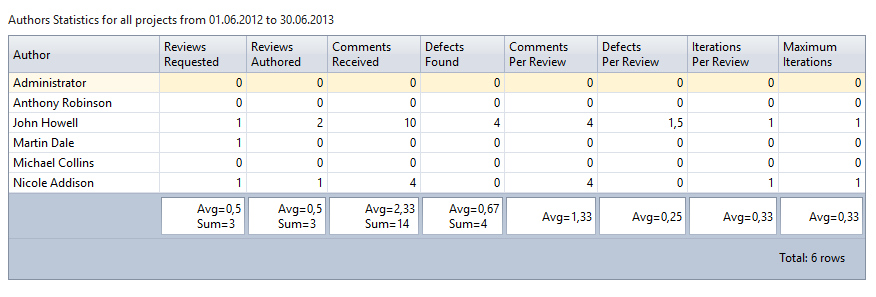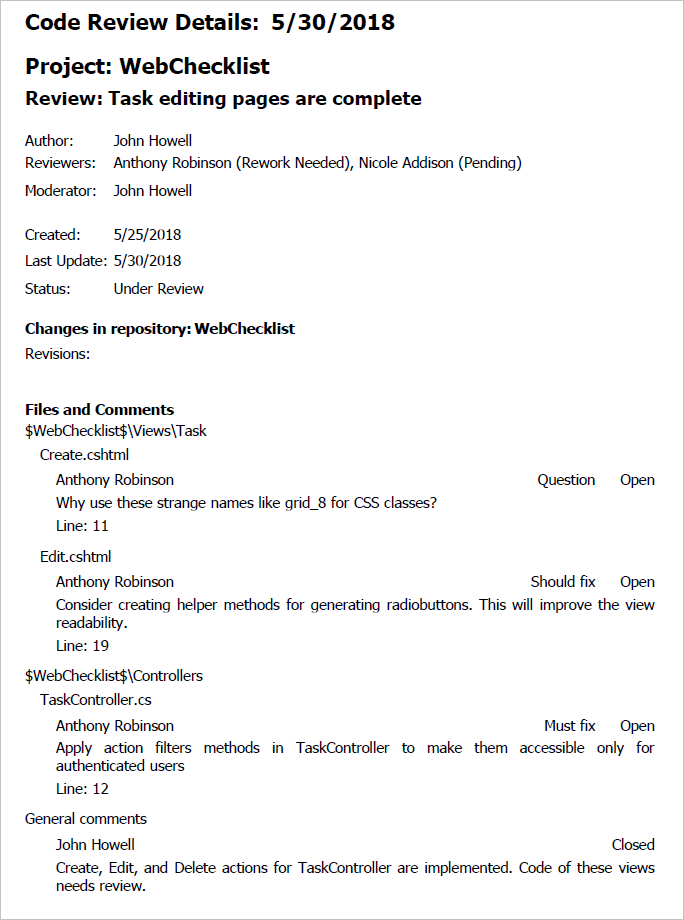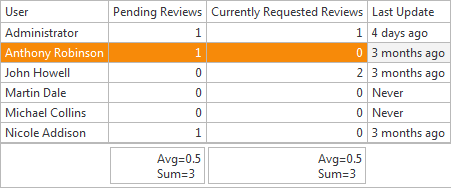Reports Overview
Review Assistant collects a variety of metrics automatically. This section describes these metrics. A later section discusses what these metrics can tell users.
Report Types
The following report types are provided:
-
Authors Statistics
-
Code Coverage
-
Code Review Details
-
Reviewers Statistics
-
Reviews Status
-
Users Status
Authors Statistics
This type of report allows you to see how often an author requests the code review and how many comments reviewers add to the code. The report allows to roughly estimate the code quality. All reviews despite of their status are displayed in the report.
The report table contains the following columns:
Author — a list of reviews’ authors.
Reviews Authored — a number of reviews, in which a user is an author.
Reviews Requested — a number of reviews created by a user regardless of his/her role in the reviews.
Comments Received — a number of received comments.
Defects Found — a number of defects found.
Comments Per Review — the average number of received comments per one review.
Defects Per Review — the average number of defects found per one review.
Iterations Per Review — the average number of iterations per one review.
Maximum Iterations — the total number of iterations.

Code Coverage
The report allows to quickly distinguish reviewed and unreviewed revisions in a repository.
The report table contains the following columns:
Revision — the number of the revision.
Status — the current status of the revision.
Date — the date, when the revision was added to the repository.
Author — the name of the revision author.
Description — description of the revision.
Linked Reviews — names of the reviews, linked to the revision. Each linked review is a hyperlink, that opens the corresponding review in Code Review Board.

Code Review Details
This type of report will be useful for companies that conduct external compliance review such as PA-DSS.
The report contains:
- Review participants
- Code revisions IDs
- Create and modify dates
- Review status
- Code comments, line number, comment status, and number of replies
The report is automatically divided into pages for printing. The default file format for saving is PDF. There are many other export formats available: HTML, MHT, RTF, XLS, XLSX, CSV, Text, Image, XPS.

If you want to create a report for a single review, you can do it directly from the Code Review Board.
Reviewers Statistics
This type of report allows you to assess reviewers’ activity for a specified period of time. The closed and the accepted reviews are displayed in the report.
The report table contains the following columns:
Reviewer — a list of reviewers that take part in the selected project.
Reviews Conducted — a number of conducted reviews per one reviewer.
Comments Written — a number of comments written by a reviewer.
Defects Found — a number of defects found by a reviewer.
Comments Per Review — the average number of comments written by one user for one review.
Defects Per Review — the average number of defects found by one user for one review.

Reviews Status
The report allows to see the currently opened reviews.
The report table contains the following columns:
Review — the review title.
Author — the name of the review author.
Reviewers — the names of the reviewers.
Moderator — the name of the moderator.
Blocked By — the name of the user that didn’t finish the review process.
Last Update — last user activity.

Users Status
The report allows to estimate the current user activity and task (review) load.
The report table contains the following columns:
User — a list of users that take part in the selected project.
Pending Reviews — the total number of pending reviews.
Currently Requested Reviews — the total number of currently requested reviews.
Last Update — last user activity.
